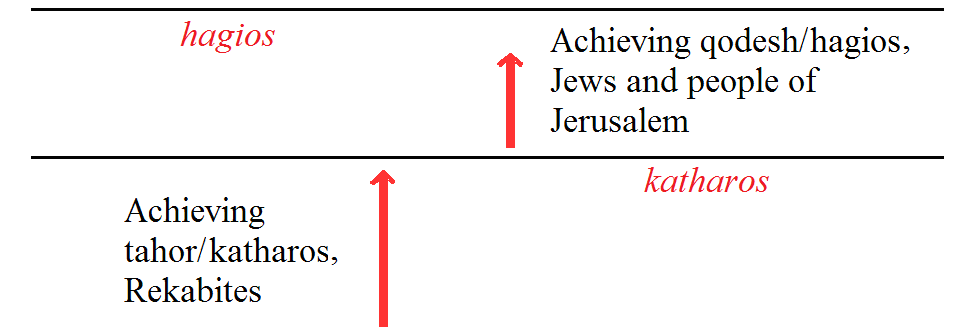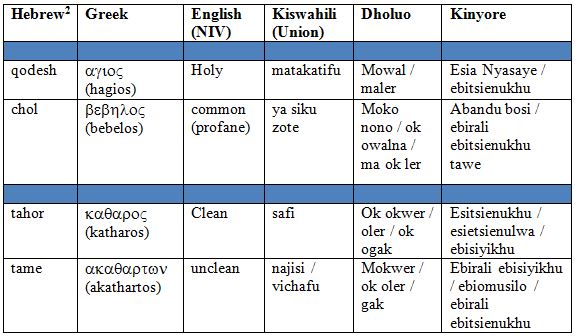Holiness in African Perspective
Praising the Rekabites
Jeremiah 35 tells us of the Rekabites. These are a people who were very intent on following the laws handed down to them from their ancestors, particularly one Jonadab (son to Rekab). Jeremiah praises the Rekabites for their adherence to the law they have been given by their forefathers. By comparison, he accuses the Jews and people of Jerusalem of failing to keep God’s laws. It would seem from this comparison that the laws given to the Jewish people are different in nature from those given to people through their ancestors. It would seem that whereas laws handed down from one’s ancestors intend to achieve a state of katharos (cleanliness), God’s laws given to his people are more difficult to follow and are oriented to producing a state of hagios (holiness). This is illustrated by diagram 1 below.
Diagram 1. Achieving different levels of holiness  Many of our African people are very preoccupied with staying holy, i.e. keeping numerous laws (such as the above). Very often the root concern in the keeping of these laws is the avoidance of death. Cause of death is invariably connected to either witchcraft powers, or to so-called spirits.
Many of our African people are very preoccupied with staying holy, i.e. keeping numerous laws (such as the above). Very often the root concern in the keeping of these laws is the avoidance of death. Cause of death is invariably connected to either witchcraft powers, or to so-called spirits.
Biblical and Traditional ‘Holiness’ I draw on Mojola (2003) on making some of the analyses below. I note that the Bible speaks of holiness on two levels:[1]
Lev. 10:10 “You must distinguish between the holy [hagios] and the common [bebelos], between the unclean [akathartos] and the clean [katharos].”
Ez. 22:26 “The priests … profane [bebelos] my holy [hagios] things; that they do not distinguish between the holy [hagios] and the common [bebelos]; they teach there is no difference between the unclean [akathartos] and the clean [katharos]; and they shut their eyes to the keeping of my Sabbaths, so that I am profaned [bebelos] among them.”
Ez. 44:23. “They are to teach my people the difference between the holy [hagios] and the common [bebelos] and show them how to distinguish between the unclean [akathartos] and the clean [katharos].”
Having identified the two levels of holiness above, I give them in tabulated form in Table 1 below in five languages: Greek, English, Kiswahili, Dholuo and Kinyore.
Table 1. Old Testament Holiness; terms from the above references tabulated 
In the Old Testament, priests were instructed to explain holiness to people (Leviticus 10:10 and Ezekiel 44:23). They were to tell them that there is a difference between unclean (akathartos) and clean (katharos), and between what we could call another category of holiness, being holy (hagios) or being common (bebelos). A state of katharos is a prerequisite for the achievement of a state of hagios (Milgrom 1991:616).[3]


